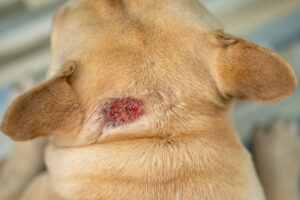Understanding and addressing periodontal disease in dogs is essential for their health and happiness. We’re here to shed light on stage 4 periodontal disease in particular and how it can be treated effectively. If you have concerns or need expert care for your pet, Creekside Pet Care Center in Keller, Texas, is just a call away at (817) 421-5850. Our team is ready to assist you with your pet’s dental health needs.
What is Periodontal Disease in Dogs?
Periodontal disease is a common yet serious dental condition that affects the structures supporting the teeth. It begins with the simple formation of plaque, a sticky film composed of food particles, saliva, and bacteria. When plaque accumulates and hardens into tartar, it leads to inflammation of the gums, known as gingivitis. If left untreated, this condition can progress, affecting the deeper structures of the teeth, including the bone, and can lead to significant oral and systemic health problems.
The Four Stages of Periodontal Disease
Gingivitis: This initial stage is marked by swollen, red gums due to inflammation. It’s the only stage where the disease is reversible with proper dental care.
Early Periodontitis: At this point, slight bone loss not visible to the naked eye occurs. The gums may start to recede, and the condition is no longer reversible, though further progression can be stopped with appropriate care.
Moderate Periodontitis: This stage is characterized by noticeable bone loss, which can be seen on dental X-rays. The gums recede further, and there might be signs of root exposure and tooth mobility.
Advanced Periodontitis: This severe stage involves significant bone loss, leading to loose teeth, severe gum recession, and a high risk of oral pain and infection.
What are the Signs of Stage 4 Periodontal Disease?
Stage 4 periodontal disease in dogs is not just a dental issue but a serious, systemic health concern. Symptoms to look for include:
- Severe gum inflammation and recession, where the gums severely pull away from teeth, exposing the roots.
- Loose or missing teeth are caused by extensive damage to the tooth’s supporting structures.
- Persistent bad breath is caused by bacteria and decaying dental tissue.
- Bleeding gums may occur during eating or when the gums are touched.
- Appetite loss or difficulty eating may occur as a result of oral discomfort.
- Advanced disease can lead to infection spreading to the nasal cavity, resulting in nasal discharge and sneezing.
Treating Stage 4 Periodontal Disease
Treatment for stage 4 periodontal disease in dogs is comprehensive and typically involves the following steps:
- Professional Dental Cleaning: This procedure is done with the patient under anesthesia and involves a thorough cleaning above and below the gum line, including scaling and root planing.
- Tooth Extractions: Teeth that are severely affected and cannot be saved are carefully removed.
- Antibiotics and Pain Management: These are critical to controlling the infection and alleviating discomfort.
- Ongoing Care: Continuous care, including regular checkups and cleanings, is essential to monitor your dog’s oral health post-treatment.
Life After Treatment
Treating stage 4 periodontal disease can be a life-changing experience for dogs. Once the pain and discomfort caused by this severe dental condition are addressed, many dogs display a remarkable turnaround in their behavior and overall well-being.
A Renewed Quality of Life
After treatment, dogs often show:
- Improved Appetite: Many dogs resume normal eating habits as oral discomfort diminishes.
- Increased Activity and Playfulness: Relief from pain can lead to a more active lifestyle.
- Better Breath: Treatment significantly reduces halitosis caused by bacteria and decaying tissue.
- More Social Interaction: Dogs become more comfortable engaging with family members and other pets without oral pain.
Long-Term Health Benefits
Besides immediate improvements, treating advanced periodontal disease also contributes to your dog’s long-term health. By addressing oral infections, you also reduce the risk of systemic issues such as heart and kidney diseases.
Preventing Periodontal Disease
Preventing periodontal disease is much more than just maintaining fresh breath; it’s about ensuring the overall health and happiness of your dog. Prevention starts with understanding that dental health is a vital component of your pet’s health care and requires regular attention, such as pet dental checkups.
Daily Dental Care
- Regular Brushing: Daily brushing with dog-specific toothpaste helps prevent plaque and tartar buildup.
- Dental Treats and Chew Toys: Chewing on specially designed toys and treats can help clean teeth mechanically.
Professional Dental Checkups
- Routine Veterinary Visits: Regular checkups allow your veterinarian to monitor your pet’s dental health and address issues early.
- Professional Cleaning: Periodic professional cleaning by your veterinarian removes plaque and tartar buildup that can’t be reached by brushing.
Diet and Nutrition
- Special Dental Diets: Certain diets are formulated to reduce tartar and plaque buildup.
- Healthy Treats: Opt for treats that promote dental health rather than those that contribute to plaque buildup.
Education and Awareness
- Stay Informed: Understanding the signs of dental problems helps with early detection and treatment.
- Veterinary Guidance: Regular discussions with your vet about your dog’s dental health can provide valuable insights and enhance your pet’s treatment.
Partner with Creekside Pet Care Center for Your Dog’s Dental Care
At Creekside Pet Care Center, we are dedicated to helping you maintain your dog’s dental health for life. Our team provides not just treatment but also education and resources to ensure your pet’s happiness and longevity. Contact us at (817) 421-5850 to learn more about our dental care services and how we can help prevent periodontal disease in your dog.






